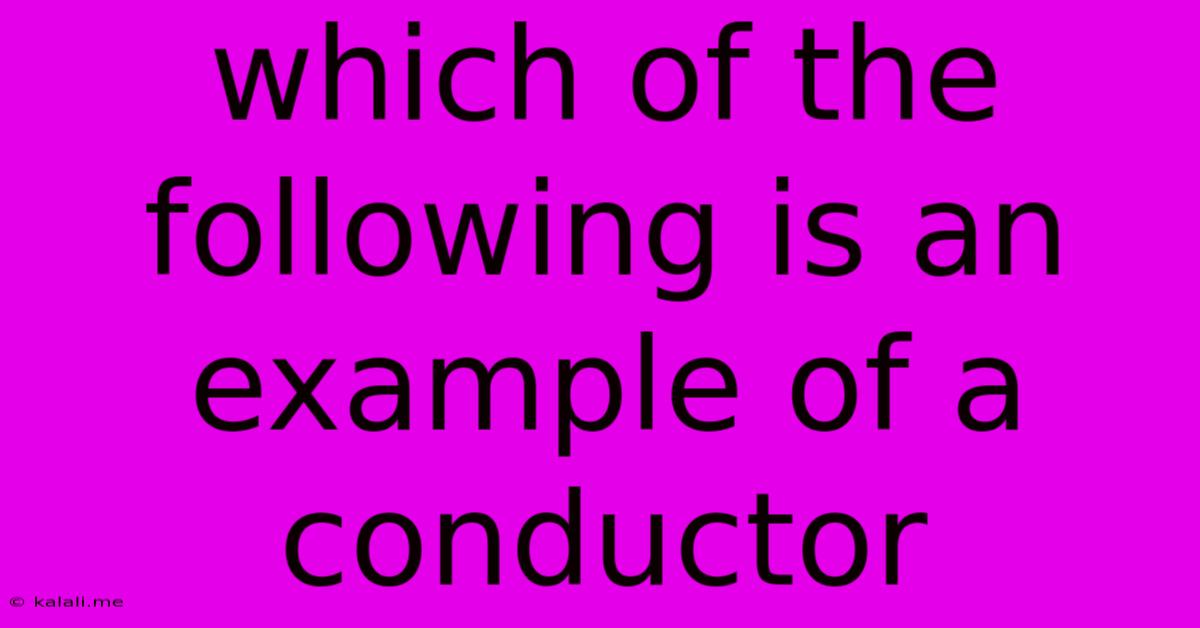Which Of The Following Is An Example Of A Conductor
Kalali
Jun 14, 2025 · 3 min read

Table of Contents
Which of the Following is an Example of a Conductor? Understanding Electrical Conductivity
This article will explore the concept of electrical conductivity and provide clear examples of conductors, insulators, and semiconductors. Understanding the difference is crucial in various fields, from electrical engineering to materials science. We'll delve into the atomic structure that explains why certain materials conduct electricity effectively, while others don't.
What is a Conductor?
A conductor is a material that allows the flow of electric charge (electrons) through it easily. This is due to the presence of loosely bound electrons in its atomic structure. These free electrons are readily available to move when an electric field is applied, creating an electric current. The ease with which this happens is measured by the material's conductivity. High conductivity means the material is an excellent conductor.
Examples of Conductors:
Many everyday materials are excellent conductors. Here are some common examples:
-
Metals: Metals are the most common and effective conductors. Their atomic structure features a "sea" of delocalized electrons, freely moving between atoms. Examples include:
- Copper: Widely used in electrical wiring due to its high conductivity and affordability.
- Aluminum: Lighter than copper, making it suitable for power lines.
- Gold: Excellent conductor, often used in electronics where corrosion resistance is vital.
- Silver: The best conductor of electricity among metals, but its high cost limits its widespread use.
- Iron: Used extensively in various applications, including electromagnets.
-
Electrolytes: These are solutions containing ions that can move and carry electric charge. Examples include:
- Saltwater: Dissolved salt ions facilitate the movement of charge.
- Acidic solutions: The presence of H+ ions contributes to conductivity.
- Alkaline solutions: OH- ions contribute to conductivity.
-
Plasma: A state of matter where electrons are stripped from atoms, creating a highly conductive medium. Lightning is a dramatic example of plasma conductivity.
Materials that are NOT Conductors:
To fully grasp the concept of a conductor, it's also important to understand materials that are not conductors. These include:
-
Insulators: These materials strongly resist the flow of electric current. Their electrons are tightly bound to their atoms and cannot move freely. Examples include:
- Rubber: Used in electrical insulation.
- Glass: An excellent insulator, commonly used in various applications.
- Plastic: Widely used in electrical components for insulation.
- Wood: A poor conductor of electricity.
-
Semiconductors: These materials have electrical conductivity between conductors and insulators. Their conductivity can be manipulated through doping or temperature changes. Examples include:
- Silicon: The most common semiconductor used in integrated circuits.
- Germanium: Another important semiconductor material.
Choosing the Right Material:
The choice of conductor depends greatly on the specific application. Factors like cost, conductivity, durability, and corrosion resistance are all important considerations. For example, copper's excellent conductivity and affordability make it ideal for household wiring, while gold's corrosion resistance makes it preferable for sensitive electronics.
In Conclusion:
Understanding the properties of conductors is essential for many technological advancements. This article has provided a clear overview of conductors, highlighting key examples and contrasting them with insulators and semiconductors. Remember, the key characteristic of a conductor is its ability to allow the easy flow of electric charge due to the presence of freely moving electrons.
Latest Posts
Latest Posts
-
How Many Chambers In A Fish Heart
Jun 15, 2025
-
Give A Suitable Title To The Passage Answer
Jun 15, 2025
-
Letter Format For Bank Account Closing
Jun 15, 2025
-
The Asteroid Belt Lies Between The Orbits Of
Jun 15, 2025
-
Milk Of Magnesia Base Or Acid
Jun 15, 2025
Related Post
Thank you for visiting our website which covers about Which Of The Following Is An Example Of A Conductor . We hope the information provided has been useful to you. Feel free to contact us if you have any questions or need further assistance. See you next time and don't miss to bookmark.